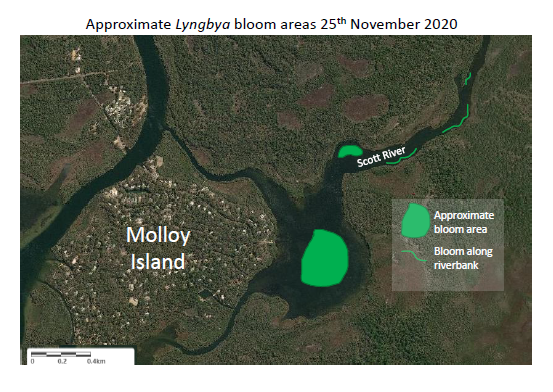The Department of Health is warning people to avoid contact with a Lyngbya sp. macro-algal bloom that has formed in the Scott River Basin east of Molloy Island and upstream of the Scott River confluence within the Shire of Augusta-Margaret River (see map below).

Executive Director, Environmental Health Dr Mike Lindsay said the algae has a greeny-brown clumpy and filamentous appearance in the water, and contact with the algae can potentially cause burning, itching or blistering to the skin and respiratory problems in some people. Ingestion of affected water may also cause dizziness, diarrhoea, vomiting, disorientation, respiratory distress and skin irritation.
“Recreational activities such as swimming, wading, kayaking, paddle-boarding, skiing fishing, crabbing and shellfish collection should be avoided in these affected water areas, and any other areas where algal scum may form, or discolouration is visible,” he said.
“Pets and livestock should also be kept away from the water during the bloom.”
Dr Lindsay said the Shire of Augusta-Margaret River will display algal bloom signage at the Molloy Island: Caravan Park and Ferry Crossing, and will also erect health warning sign at the main accessible points leading into the affected water area.
Anyone who comes in contact with algal scum should rinse it off with clean water and seek medical attention if they feel unwell.
“As a general rule people should avoid swimming in water that is discoloured or has algal scum on the surface, and not eat shellfish collected recreationally as their safety cannot be guaranteed,” he said.
Dr Lindsay said farmed shellfish purchased in supermarkets and other commercial outlets in WA are not affected as there is a strict quality-assurance program to ensure they are safe for human consumption.
Not all waterways are always monitored for algal blooms and anyone who sees or suspects an algal bloom in a waterway, should report this to the Department of Water and Environmental Regulations’ ALGALWATCH during office hours on 6250 8064 or to the local government authority for assessment.
The Department of Water and Environmental Regulations will continue to monitor the algal bloom and provide advice to the Department of Health on algal activity levels in this location.
Learn more about algal bloom monitoring in Western Australia.
Media contact: 9222 4333
Follow us on Twitter: @WAHealth